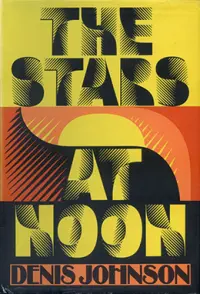images: Alfred A. Knopf / A24
The Stars at Noon, by the late, great Denis Johnson, is the kind of work one might categorize as unfilmable when you really begin to unpack its layers and symbolism. This may in part explain why no one attempted — at least in earnest — a film adaptation until 2022, when famed French director Claire Denis, writing alongside Léa Mysius and Andrew Litvack, finally brought Johnson’s third book to the screen 36 years after its initial publication.
This delay from novel to movie could also stem from the author’s own detachment from the text, given that it is largely autobiographical and based on a particularly dark and lonely time in Johnson’s life; he was even tapped by HBO at one point to write the screenplay himself, but disliked revisiting the material and the constant meddling from studio executives. As Denis tells the Los Angeles Times, when she met Johnson in the early 2000s, he was totally on board for her to adapt the book, but other than asking her not to change very much of it, had no real interest in being involved in the project. After his passing in 2017, Denis made it her mission to complete the project, and keep “the spirit of Denis [Johnson]” alive in the film, to “stay close to Denis” as she could.
Did Denis’s efforts pay off? How does her film compare to Johnson’s slim but no less epic work of fiction? Let’s dive in and find out.
The Book
Set in Nicaragua 1984 during the country’s socialist Sandinista revolution, Johnson’s novel centers on an unnamed American woman who has found herself in dire straits in a foreign land. Told in first person narration, she slowly reveals throughout the story that she came to Nicaragua as an “observer” for a peace organization, but upon seeing numerous war atrocities, became disillusioned (read: possibly had a mental breakdown) and abandoned her post. Clinging to her journalist status as a potential means of income, the woman makes most of her money as a sex worker in the capitol city of Managua, picking up high-end clients at the swanky Intercontinental hotel, where the men can usually pay in U.S. dollars — important because the cordoba, the country’s currency, is pretty much toilet paper at this point in history, and while she’s rich in ass-wiping bills, she’s quite poor otherwise.
It’s inside this hotel’s bar she meets a man who becomes known only as “the Englishman” — no one, by the way, has a proper moniker in Johnson’s text, a component of his using the poverty and political strife of Nicaragua as a metaphor for Hell, and in Johnson’s own words, he “thought it was appropriate that the people in Hell wouldn't have any names.” The protagonist seems to know all too well the Inferno she currently occupies. As Caryn James states in her contemporary review for the New York Times, the character “claims she has come to Nicaragua to discover ‘the exact dimensions of Hell,’ but seems bent on losing all trace of consciousness or conscience.” The narrator accomplishes this disassociation largely through alcoholism and an intensifying pessimism that masks her true kindness within (though a “hooker with a heart of gold” stereotype this character is not).
While their relationship is initially transactional, the woman and the Englishman — described in misty, almost phantasmagorical terms, as though he hardly even exists — eventually fall in love, particularly after she helps him evade a Costa Rican policeman with a score to settle. It turns out the Englishman works for an oil company looking to plunder an apparent rich deposit that technically also falls on the Costa Rica side of the border. In an act of what he perceives as humanitarianism, the Englishman alerted Nicaraguan officials to the oil, deciding it was more rightfully theirs than their neighbors down south. This corporate espionage also puts an American “consultant” (most likely a CIA agent) on the Englishman’s tail, who believes the Brit has "fuck[ed] with the arrangement” because he gave the Central American region a power-up by revealing the site of the oil (the most valuable currency in this narrative and, indeed, in the real world too). This consultant fears the move may allow Fidel Castro to further bolster Nicaragua’s socialist movement, which of course disrupts the machinations of the U.S. and capitalism overall, which is to keep the rich rich and the poor poor.
 Most of the novel’s second half follows the woman and the Englishman as they flee the forces out to get them, traveling deeper into the country’s rural areas, their accommodations more rustic, the poverty more glaring as they go. There’s an aimlessness to their flight, and the characters must reckon with their own folly and the lack of proper planning surrounding their escape. They even realize how foolish it was to head for Costa Rica, given that the Englishman is wanted by the law there; they should’ve gone north to El Salvador or Honduras. But by the time they figure this out, they’re apprehended, and the protagonist, having been worn down by the stress of being chased and the Englishman’s constantly shifting moods (not to mention his abject helplessness), ends up stabbing her travel companion in the back, signing documents that affirms his guilt — a move that gets her a fat stack of cash from the consultant and a free pass to San Jose. The novel ends with the woman working at a brothel and being propositioned by a man who bears an uncanny resemblance to the Englishman, furthering Johnson’s motif of cyclical actions and happenings — the denizens of Hell, the author makes clear, are like Sisyphus forever rolling his rock up that hill, repeating their mistakes and deeds over and over again, seemingly for eternity.
Most of the novel’s second half follows the woman and the Englishman as they flee the forces out to get them, traveling deeper into the country’s rural areas, their accommodations more rustic, the poverty more glaring as they go. There’s an aimlessness to their flight, and the characters must reckon with their own folly and the lack of proper planning surrounding their escape. They even realize how foolish it was to head for Costa Rica, given that the Englishman is wanted by the law there; they should’ve gone north to El Salvador or Honduras. But by the time they figure this out, they’re apprehended, and the protagonist, having been worn down by the stress of being chased and the Englishman’s constantly shifting moods (not to mention his abject helplessness), ends up stabbing her travel companion in the back, signing documents that affirms his guilt — a move that gets her a fat stack of cash from the consultant and a free pass to San Jose. The novel ends with the woman working at a brothel and being propositioned by a man who bears an uncanny resemblance to the Englishman, furthering Johnson’s motif of cyclical actions and happenings — the denizens of Hell, the author makes clear, are like Sisyphus forever rolling his rock up that hill, repeating their mistakes and deeds over and over again, seemingly for eternity.
The Film
The biggest hurdle in adapting The Stars at Noon is, of course, the protagonist, given that film-going audiences tend to outright dismiss feminine characters who are as “unlikable” as she is. The woman is acid-tongued, often hateful toward the native people of Central America -— a spite that at times borders on outright racism. She’s deeply homophobic, and she even makes a random anti-semitic remark at one point in the novel. But she’s also broken and scared and disillusioned, often nothing more than a child looking for safety and protection. In this way, the narrator is a quintessential American: her entitlement and boorishness are mere masks covering her fear and self-loathing.
Denis emphasizes these latter qualities in the main character, softening her edges and diminishing her “every-person” function in the novel by giving her a name — Trish Johnson, the surname no doubt a tribute to the novel’s author. Starring as our damaged heroine is Margaret Qualley, who plays the character with more a wry smirk than a hardened, battle-born grimace, as though her various predicaments are just a big joke she’s totally in on. This functions in the same way as the acidity of Trish’s literary counterpart: her snarky, devil-may-care outlook is just another mask, a forced put-togetherness keeping her heels at least affixed to the cliff’s edge, even if her toes are wholly groundless. It also provides a more stark contrast dramatically speaking when the cracks in Trish’s facade appear, revealing the loneliness and desperation thriving just underneath the surface. These changes made to the protagonist work well overall, especially since most of her rougher qualities come through her first-person narration anyway, from her showing us the “exact dimensions” of her troubled mind, and having voice over in film can be hit or miss (more often than not, "miss").
The Englishman — named Daniel in the film and played by Joe Alwyn — similarly gets a makeover. Rather than being a ghostly mist of a man, he’s suave and sexy with blond, mane-like hair and a smoldering “bedroom voice.” But much like Trish, his coolness begins to slip away when the proverbial noose tightens around his neck, becoming more fearful and wracked and rumpled with every setback, creating a potent visual trajectory for the character. Without relying on Trish telling us how charming Daniel can be, the audience can clearly see why she falls for him and sticks with him to the bitter end (even if their end is primarily bitter on account of her betrayal).
The only other major change Denis makes from the source material is moving the action to modern-day rather than 1984. However, aside from removing direct references to revolution in Nicaragua and a few other minor tweaks, all the dialogue in the film is taken nearly verbatim from the text, making good on her promise not to change very much. And it’s amazing just how relevant Johnson’s words remain. Money is still the true law of the land, and where there’s capital to be had, the U.S. is sure to be there, meddling in affairs, looking out for its own self-interests. Hell isn’t Nicaragua in and of itself, both Johnson and Denis assert, but like Sartre wrote in No Exit, it’s “other people,” who see paradise and reach for a match. And, in both novel and film, stuck in the middle of this man-made morass are two people who, deep down, want to do good and love each other, and ultimately receive punishment for these desires.
In this way, Denis’s film admirably captures the spirit and crux of Johnson’s novel, even if it comes at it from a slightly different angle. Despite its modern-day setting, the movie feels timeless precisely because Denis focuses on the central, doomed romance between the two characters, creating a noir-ish drama of the heart.
Get The Stars at Noon at Bookshop or Amazon

About the author
Christopher Shultz writes plays and fiction. His works have appeared at The Inkwell Theatre's Playwrights' Night, and in Pseudopod, Unnerving Magazine, Apex Magazine, freeze frame flash fiction and Grievous Angel, among other places. He has also contributed columns on books and film at LitReactor, The Cinematropolis, and Tor.com. Christopher currently lives in Oklahoma City. More info at christophershultz.com








